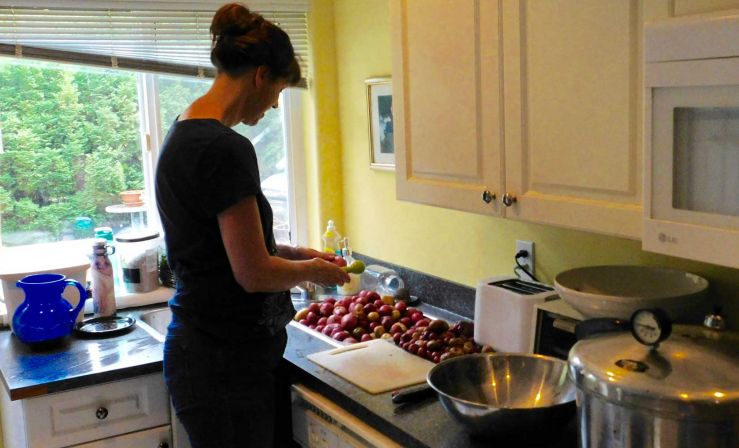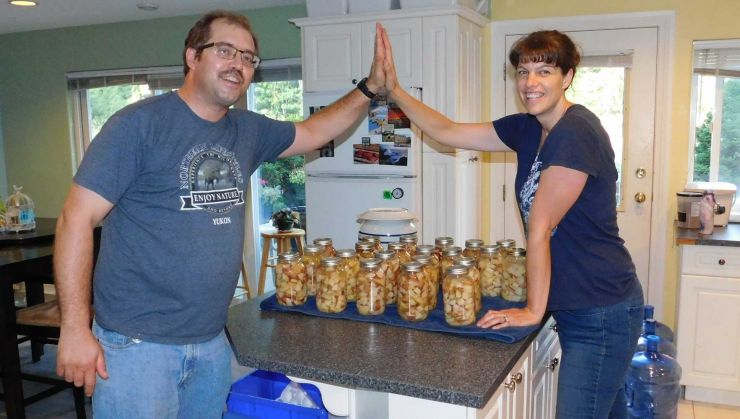
The old school has become new school. If you're like me you grew up with a mom who did lots of canning. At the time I didn't pay much attention except to enjoy the fruits of her labor. Now, some thirty years later, my husband and I are canning together. Canning is a great way to preserve fruit, vegetables, pickles, meats, jam, salsa and soup. In this article, I will talk about peaches and potatoes and how my husband and I go about canning ours. Improper canning can result in food going bad, which can lead to botulism. This is a serious health risk and we recommend that you follow the instructions of certified canners. We do not have certification and are simply sharing what we do when we can. There are two options in canning: a canning pot with a round jar rack or with using a pressure canner. Personally, I like to use a pressure canner so that is what will be shared here.
Ramona Stevens

- Clean canning jars with lids and rings, (the rings can be reused but the lids need to be replaced every year)
- Pressure canner with rubber sealing ring
- 2 Large mixing bowls
- Spatula
- 1 Small pot and 1 medium pot
- Paper towels
- Canning jar lifter
- Magnetic canning lid lifter
- Apple juice (dilute with water if you desire less sweet. I do 1/2 juice to 1/2 water)
- Cutting board
- Paring knife
- Canning funnel
50 pounds of peaches fills about 15, 1 litre canning jars and requires about 7 litres of
apple juice.
Process:
- 1) We preheat the oven to 90 degrees celsius and place our canning jars in the oven to warm without the lids and rings. Later, the jars will be placed in hot water so warming the jars first prevents them from cracking due to a sudden change in temperature.
- We place the lids and rings in the small pot and pour water in to cover them. We place this on our stove top on medium heat to keep warm.
- We fill our medium pot with apple juice and place it on our stove top on medium heat to keep it hot.
- We fill our pressure canner with water to about 3 inches depth, then place our pressure canner on stove top on high heat.
- We dip the peaches in boiling water for 30-60 seconds to loosen the skins. Then we dip the peaches in cold water and the peal slips off. Next, we cut the peaches into halves or quarters and remove the pit. We set the peaches aside in the mixing bowl.
- Using our canning jar lifter, we remove one jar at a time from the oven and pack it with the sliced peaches.
- We place the canning funnel on top of the jar and pour the apple juice in to cover the peaches, being careful to leave 1/2 inch head space.
- With our spatula we push the peaches down to release air bubbles.
- We wipe the rim of the jar with a paper towel.
- Using the magnetic lid lifter we remove a lid and ring from the hot water on the stove and seal the jar.
- Using the canning jar lifter, we place our filled jar into the pressure canner.
- We repeat till our canner is full, then we seal the canner and adjust element heat as needed till the canner shows 6 pounds of pressure. We cook for 10 minutes.
- After 10 minutes we move the pressure canner off the hot element. We carefully remove the pressure regulator to allow steam to escape and the canner to cool. Once the pressure has returned to zero, we safely remove the canner lid.
- Using the canning jar lifter, we remove each jar and place it on top of a towel on our counter. We allow to cool completely before moving the jars to a desired location.
At first glance it looks complicated, but with a little practise, we found our groove and the reward has been delicious canned peaches that can last all year long. A jar of canned peaches can be used to make snacks, desserts or even given as a gift.

The list of items that we use is the same as for canning peaches except the liquid used to preserve, instead of apple juice, is a combination of water, lemon juice and salt. The prep time for canning potatoes is shorter than that of canning peaches because potatoes don't need to be peeled. However, the cook time is longer.
The prep of jars, pressure cooker and lids will be the same as for peaches. In a medium pot, we heat water as the preserving liquid.
- We wash and dice potatoes in 1 inch pieces and set aside in a large bowl.
- Using the canning jar lifter, we remove 1 jar at a time from the oven and pack with diced potatoes.
- We place the canning jar funnel on top of the jar and pour boiling water to cover the potatoes, leaving 1/2 inch head space.
- We add salt and lemon juice.
- With our spatula, we push the potatoes down to release air bubbles.
- We wipe the rim of the jar with a paper towel.
- We seal the jar and use the canning jar lifter to place it in the pressure canner.
- We repeat till the canner is filled and then place the lid on with the pressure regulator and adjust the element heat as needed till the canner shows 11 pounds of pressure. We cook for 40 minutes.
- After 40 minutes we move the pressure canner off the hot element. We carefully remove the pressure regulator to allow steam to escape and the canner to cool. Once the pressure has returned to zero we safely remove the canner lid.
- Using the canning jar lifter, we remove each jar and place on top of a towel on our counter. We allow to cool completely before moving the jars to desired location.
We drain out the liquid. Then toss the potatoes in a large mixing bowl with 1/4 cup olive oil, 1 tbsp of each: rosemary, thyme, and basil or 3 tbsps of Italian seasoning. We bake the potatoes on a cookie sheet for 45-60 minutes at 350 degrees celsius.
